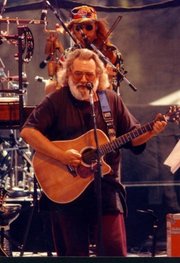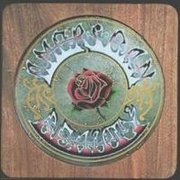Grateful Dead
|
|

The Grateful Dead's career began, under the name The Warlocks, in the San Francisco psychedelic rock scene of the 1960s. Many bands from this area went on to national fame, such as Jefferson Airplane and Big Brother & the Holding Company, garnering San Francisco an image as a center for the hippie counterculture of the era. Of these bands, the Grateful Dead had the "most musicianly background", including banjo and guitar player Jerry Garcia, blues musician Pigpen McKernan, the classically trained Phil Lesh and drummer Bill Kreutzmann Template:Ref. In addition, the Grateful Dead most embodied "all the elements of the San Francisco scene and came, therefore, to represent the counterculture to the rest of the country" Template:Ref.
Playing originally as The Warlocks, and later Grateful Dead (a name chosen at random from the dictionary by Jerry Garcia), the band became the de facto resident band of Ken Kesey's Merry Pranksters, with the early sound heavily influenced by Kesey's LSD-soaked Acid Tests as well as R&B. Their musical influences varied widely with input from the psychedelic music of the era, combined with blues, jazz, and bluegrass. These various influences were distilled into a diverse and eclectic whole that made the Grateful Dead "one of the most experimental and improvisatory bands in rock" Template:Ref.

| Contents |
Membership
As de facto bandleader—despite his own unwillingness to lead, a condition that almost ran the band into the ground on several occasions—Jerry Garcia played lead guitar (though his other instrumental love was banjo and he had come from a bluegrass music background up to 1964, before ever meeting future Grateful Dead members; he also played with mandolinist David Grisman in a bluegrass outfit called Old and in the Way). Classically-trained musician Phil Lesh played bass guitar. Bob Weir, the youngest member of the group, played rhythm guitar. Ron "Pigpen" McKernan played keyboards, harmonica and was also a group vocalist until his death in 1973. All of the previously mentioned Grateful Dead members shared in vocal performance of songs. Bill Kreutzmann played drums, and in September 1967 was joined by a second drummer, New York native Mickey Hart, who also played a wide variety of other percussion instruments. Hart quit the Grateful Dead in 1971, embarrassed by the actions of his father, Dead money manager Lenny Hart (for whom the song "He's Gone" is penned), leaving Kreutzmann once again as the sole drummer. Hart rejoined the Dead for good in 1975. Tom "TC" Constanten played keyboards alongside Pigpen from 1968 to 1970. Two years later in late 1971, Pigpen was joined by another keyboardist, Keith Godchaux, who played grand piano alongside Pigpen's Hammond B-3 organ. In early 1972, Keith's wife, Donna Jean Godchaux, joined the Dead as a backing vocalist. Keith and Donna were fired from the band in 1979, and Brent Mydland joined as keyboardist and vocalist. Keith Godchaux died in a car accident in 1980. Brent Mydland was the keyboardist for the Dead for 11 years until his death in 1990. He became the third Dead keyboardist to die. Almost immediately, former Tubes keyboardist Vince Welnick joined on keyboards and vocals. For a year and a half, Welnick was often joined by special guest Bruce Hornsby on piano. Robert Hunter and John Perry Barlow were the band's lyricists. Owsley "Bear" Stanley was the Grateful Dead's soundman for many years; he was also one of the largest suppliers of LSD.
Touring
The Grateful Dead are well-known for their near constant touring throughout their long career in music. They promoted a sense of community among their fans, who became known as Deadheads and who followed their tours for months or years on end. The band was also dedicated to their community, the Haight-Ashbury area of San Francisco, making available free food, lodging, music and health care to all comers; they were the "first among equals in giving unselfishly of themselves to hippie culture, performing 'more free concerts than any band in the history of music'" Template:Ref.
With the exception of 1975, the Grateful Dead toured regularly around the USA from the winter of 1965 until July 9, 1995—with a few detours to Canada, Europe and three nights at the Great Pyramid of Giza in Egypt in 1978. Their numerous studio albums were generally collections of new songs that had been initially played in concert. The band was famous for their extended jams, which showcased both individual improvisation as well as a singularly unique "group-mind" improvisation where each of the band members improvised individually, while still blending together as a cohesive musical unit, often engaging in extended improvisational flights of fancy. A hallmark of their concert sets were continuous sets of music where each song would blend into the next (a segue). Musically this may be illustrated in that the band not only improvised within the form of a song, yet also improvised with the forms.
Wall of Sound
The Wall of Sound was an enormous structure of speakers designed by Bear. The band built up The Wall over time, investing the bulk of their earnings back into their sound technology, because their motive was to deliver the best possible sound to their audience.
They added several speakers each year until the wall was 32 feet high and weighed several thousand pounds. Because the wall had to be placed behind the band, vocalists sang into a phase canceling microphone setup to eliminate feedback. There were two microphones: a top and bottom. They sang into the top microphone, while the bottom microphone picked up sound from the wall. The sound wave from the bottom microphone was then inverted and inserted into the top microphone output. Because of the technology available at the time, this resulted in poor vocal quality.
Deadheads
Many of their fans, commonly referred to as Deadheads, would follow the band on tour. In contrast to many other bands, the Grateful Dead encouraged their fans to tape their shows. For many years, almost all of their shows would have dedicated taping sections. The band allowed sharing of tapes of their shows, as long as no profits were made on the sale of their show tapes. In the 1980s, the band scored a top 40 hit with the song "Touch of Grey" (from In the Dark), which garnered a much younger and more mainstream fandom that was considered sharply different from the traditional Deadheads.
Live releases
Starting in 1991, the Grateful Dead released numerous live concerts from their archives in two concurrent series: the From the Vault releases are multi-track remixes, whereas the Dick's Picks series are based on two-track mixes made at the time of the recording. There have been at least 35 DP releases as of June 2005. A series of videos began to trickle out of "The Vault", starting with View From the Vault (recorded in Pittsburgh on July 8, 1990 at Three Rivers Stadium) and View from the Vault II (recorded in Washington, DC on June 14, 1991 at RFK Stadium); these releases are accompanied by the simultaneous release of multi-disc soundtrack CDs of the same shows represented on the videos. All three series of releases continue to this day.
History
The early records reflected their live repertoire—lengthy instrumental jams with guitar solos by Garcia, best exemplified by "Dark Star"—but lacked the energy of the shows and did not sell terribly well. The 1969 live album Live/Dead did capture more of their essence, but commercial success did not come until Workingman's Dead and American Beauty, both released in 1970. These records featured the band's laid-back acoustic musicianship and more traditional song structures.
Dissolution of the band
Following Garcia's death in 1995, the remaining members formally decided to retire the name "Grateful Dead". Though some of them occasionally toured through the late 1990s under the name "The Other Ones", they mainly chose to pursue various solo projects, most notably Bob Weir's Ratdog, Phil Lesh and Friends and Mickey Hart's music for the 1996 Olympics. The remaining members occasionally got together under the pseudonym Crusader Rabbit Stealth Band during the late 1990s, infrequently playing unannounced shows. The mid-2002 fall tour of The Other Ones, with Bob, Bill, Phil and Mickey, was so successful and satisfying that the band decided the name was no longer appropriate. On February 14, 2003, (as they said) "reflecting the reality that [was]," they renamed themselves The Dead, keeping "Grateful" retired out of respect for Garcia.
Original members
- Jerry Garcia - guitar, vocals (1965 - 1995)
- Bob Weir - guitar vocals (1965 - 1995)
- Phil Lesh - bass, vocals (1965 - 1995)
- Bill Kreutzmann - drums (1965 - 1995)
- Ron "Pigpen" McKernan - keyboards, vocals, harmonica, percussion (1965 - 1973)
Other Members
- Mickey Hart - drums (1967 - 1971, 1975 - 1995)
- Tom Constanten - keyboards (1968 - 1970)
- Keith Godchaux - keyboards (1971 - 1979)
- Donna Jean Godchaux - vocals (1972 - 1979)
- Brent Mydland - vocals, keyboards (1979 - 1990)
- Vince Welnick - vocals, keyboards (1990 - 1995)
Discography
- The Grateful Dead 1967
- Anthem of the Sun 1968
- Two from the Vault 1968
- Live/Dead 1969
- Aoxomoxoa 1969
- History of the Grateful Dead, Volume One (Bear's Choice) 1970
- American Beauty 1970
- Workingman's Dead 1970
- Grateful Dead 1971
- Hundred Year Hall 1972
- Europe '72 1972
- Skeletons from the Closet (Best of the Grateful Dead) 1973 (compilation)
- Wake of the Flood 1973
- Grateful Dead from the Mars Hotel 1974
- Steal Your Face 1974
- One from the Vault 1975
- Blues for Allah 1975
- Terrapin Station 1977
- What a Long Strange Trip It's Been 1977 (compilation)
- Shakedown Street 1978
- Go to Heaven 1980
- Dead Set 1981
- Reckoning 1981
- In the Dark 1987
- Built to Last 1989
- Dylan and the Dead 1989
- Dozin' at the Knick 1990
- Without a Net 1990
- Infrared Roses 1991 (live compilation)
- Grayfolded 1996 (live compilation)
- Grateful Dead 1977-1995 1996
- The Arista Years 1996 (compilation)
- Fallout from the Phil Zone 1997 (live compilation)
- So Many Roads 1965-1995 1999 (boxed set)
- Golden Road 2001
- Postcards of the Hanging 2002 (live compilation)
- Beyond Description 2004
- Rare Cuts and Oddities 1966 2005
See also
Samples
- Download sample of "Box of Rain" from American Beauty
References
Notes
- Template:Note Rolling Stone, pg. 332
- Template:Note Garofalo, pg. 218
- Template:Note Garofalo, pg. 219
- Template:Note Garofalo, pg. 219, quote in Garofalo, cited to Roxon, Lillian Roxon's Rock Encyclopedia, 210
External links
- Official Grateful Dead Home Page (http://www.dead.net/)
- The DeadLists Project (http://www.deadlists.com/)
- The Jerry Site (http://www.thejerrysite.com/)
- The SetList Program (http://www.setlists.net/)
- The Grateful Dead Family Discography (http://www.deaddisc.com/)
- The Compleat Grateful Dead Discography (http://tcgdd.freeyellow.com/)
- The Annotated Grateful Dead Lyrics (http://arts.ucsc.edu/gdead/agdl/)
- The Grateful Dead Lyrics Page (http://www.myclassiclyrics.com/grateful_dead/grateful_dead_Lyrics.htm)
- Spirit Plants / find "The Groove" (http://www.spiritplants.com/)
- Extensive song lyrics and tab (http://www.rukind.com/)
- Download Grateful Dead concerts (shn, flac, ogg, mp*) / listed by listener rating (http://www.archive.org/search.php?query=Grateful%20Dead%20AND%20mediatype%3Aetree%20AND%20collection%3Aetree&sort=-%2Freviews%2Finfo%2Favg_rating%3B-%2Freviews%2Finfo%2Fnum_reviews)
- Other taper/trade - friendly bands on the Live Music Archive (http://www.archive.org/audio/etree-band-showall.php)
- Torrents of live concerts (http://bt.etree.org/index.php?sort=seeders&cat=8)de:Grateful Dead
